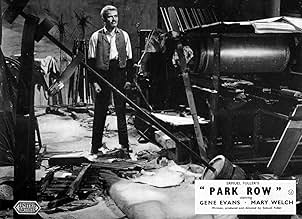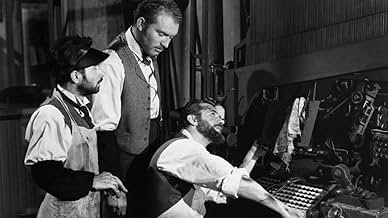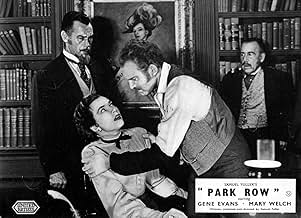The Globe is a small, but visionary newspaper started by Phineas Mitchell, an editor recently fired by The Star. The two newspapers become enemies, and the Star's ruthless heiress Charity Ha... Read allThe Globe is a small, but visionary newspaper started by Phineas Mitchell, an editor recently fired by The Star. The two newspapers become enemies, and the Star's ruthless heiress Charity Hackett decides to eliminate the competition.The Globe is a small, but visionary newspaper started by Phineas Mitchell, an editor recently fired by The Star. The two newspapers become enemies, and the Star's ruthless heiress Charity Hackett decides to eliminate the competition.
- Jenny O'Rourke
- (as Tina Rome)
- Barfly
- (uncredited)
- Barfly
- (uncredited)
- Irate Liberty Fund Contributor
- (uncredited)
- Barfly
- (uncredited)
- Director
- Writer
- All cast & crew
- Production, box office & more at IMDbPro
Featured reviews
The IMDb reviewer, st-shot, who called this movie a "valentine" hit the mark. This valentine has a fair amount going for it, but it's more flawed than faithful. A newspaperman himself (ca. 1930), Fuller prided himself on the historical accuracy of "Park Row" and there is truth behind, if not in, many of the people and events alluded to in the screenplay: The base of the Statue of Liberty, which was unveiled in 1886 when the movie takes place, was indeed partly paid for by a newspaper campaign (Joseph Pulitzer's "New York World"). A Bowery bookie named Steve Brodie did claim to have jumped off the Brooklyn Bridge that same year, and survived to both acclaim and controversy. Linotype was indeed invented by German immigrant Ottmar Mergenthaler in 1886, but it wasn't for a Park Row newspaper, it was for lawyers wanting a way to get legal papers printed faster. The young political cartoonist called "Thomas Guest" is obviously a thinly veiled Thomas Nast, who would have been in his mid-40s and very famous by 1886.
Much of that cinematic license can be forgiven, because the problem isn't the lack of historical accuracy; it's Fuller's proud claim that it WAS accurate. Perhaps he was referring to the typesetting and printing processes he shows in such loving detail-- which certainly are fun and fascinating to see.
Then there's the plot, another big problem. Melodrama was Fuller's Achilles' heel (see THE NAKED KISS for Fuller at his lawless heights) and he pours it on rather thickly here-- injured towheaded kid, heroic journalists, rival editor and publisher as the Clark Kent & Lois Lane of 1886. But, while the movie is more frenetic than energetic, there's enough camera movement and odd angles to establish this firmly as a Fuller film, and therefore worth seeing. Once.
The story is about a guy who is fired from one New York newspaper and decides to start his own. However, the deck is definitely stacked against him and a tough female newspaper owner seems willing to do anything to see his paper fail--and she takes this competition very personally. At first, she laughs off his attempts to put out a paper. But, when he starts seeing success after success, the competition becomes very dirty. In fact, the ugliness of this fight surprised me...it was THAT tough!
The film has some amazingly good camera-work--with great lighting and composition. It never looks cheap. Additionally, Evans is memorable as a tough guy who not only can out-think but out-punch his competition! His intensity is what makes the film. Overall, despite a few rough moments, it's a great textbook example that a film doesn't have to be expensive or filled with mega-stars to be a very good picture.
This is a completely fictional story, but it incorporates enough truth to be confusing. In the 1880s Park Row was newspaper row in New York City. There was a campaign that looks like crowdfunding today to finance the pedestal for the Statue of Liberty so the monument could be completed. There was an Ottmar Mergenthaler who invented the linotype machine, the first device that could easily and quickly set complete lines of type for use in printing presses. But all of these things did not take place under one roof for one newspaper. The film does have a pretty accurate depiction of newspaper printing as it occurred in the late 1800s, and that is the most interesting aspect of it.
I could deal with the confusion, but then there is the ham fisted romance/ sexual tension between The Star's Charity Hackett and The Globe's Phineas Mitchell. It reminded me of Hill Street Blues' romance between police captain Frank Furillo and public defender Joyce Davenport - If these two people really believe in what they are doing, how could they ever be attracted to one another? But then I am showing my age to explain a 70 year old movie in terms of a 40 year old TV show.
Overall, I'd recommend it. This was a passion project for Sam Fuller as he used his own money to produce it. Just be prepared for it to be a bit of an uneven ride.
Our story proper begins in that most Fuller-ish of places, a saloon. There, a bunch of hacks on New York's bestselling daily, The Star, spends their evenings swilling booze and exchanging dreams and bitter bon mots. When idealistic reporter Gene Evans takes a break from the bar to nail an epitaph to the grave of an executed man that reads 'Murdered by The Star' – an acerbic bolt of pure fury from Fuller that's among the neatest things he ever did – the 'paper's owner (Mary Welch) marches in, sacking him and his chums on the spot.
So Evans starts up the 'paper he's always dreamt of – The Globe – and cheery, impressionable young buck George O'Hanlon throws himself off the Brooklyn Bridge for a laugh, giving him a first-rate first splash. But Welch doesn't take such competition lying down, especially not from a man she quite fancies, and so begins a circulation war that spills over into resentment, hatred and good old-fashioned violence.
As you would expect, Fuller has a real feel for the material, filling his script with the usual insider terminology and slang. Leaving just enough in his account for some vodka and cigars, the writer-director-producer spent the rest of his savings – some $200,000 accrued making hit war films – on this pet project. Much of the cash went on a fastidiously complete recreation of the Park Row of his memory, including a multitude of four-storey buildings. The film's designers queried his logic, saying the tops of the structures would never be seen on camera. Fuller said he didn't care: "I had to see it all. I had to know everything was there, exact in every detail." The sets are constructed in an ingenious way that allows Fuller's camera to wind his way through the nooks and crannies of the offices, the intensity of the shooting schedule belied by the wealth of innovation behind the camera. The director's crab dolly, a wheeled platform that allowed the camera to move in any direction, aids the spectacular direction, getting us up close and personal during Evans' periodic stomps up and down the titular street, generally looking for someone to thump.
Park Row is a punchy, sometimes dynamic blend of heartfelt sentiment and acerbic cynicism that could only have come from one director. Whilst it occasionally appears over-earnest or self-congratulatory, and has too much repetition across its 80 minutes, it's flavourful and immersive, with a no-name cast that ideally suits its ink-stained universe.
Did you know
- TriviaDirector Samuel Fuller put up his own money to make the movie and lost it all.
- GoofsApproximately 20 minutes into the film, there's a wall calendar showing the date as "1886 June 15 Monday." In 1886 June 15 was a Tuesday.
- Quotes
Phineas Mitchell: The press is good or evil according to the character of those who direct it.
- Crazy creditsInstead of "The End", the picture ends with "Thirty"; newspaper jargon for "that's all. There ain't no more!"
- ConnectionsFeatured in The Typewriter, the Rifle & the Movie Camera (1996)
- How long is Park Row?Powered by Alexa
Details
Box office
- Budget
- $200,000 (estimated)
- Runtime
- 1h 23m(83 min)
- Color
- Sound mix
- Aspect ratio
- 1.37 : 1

































